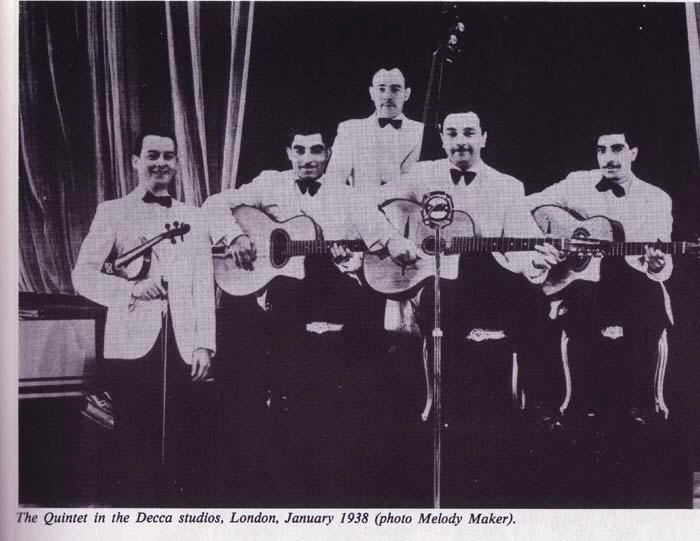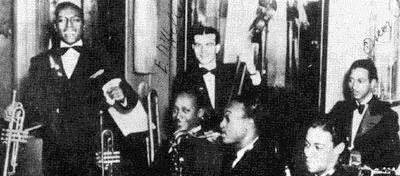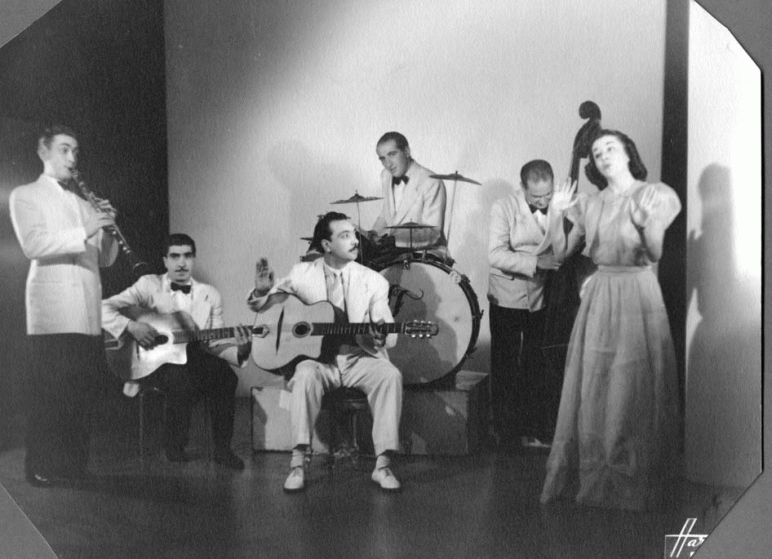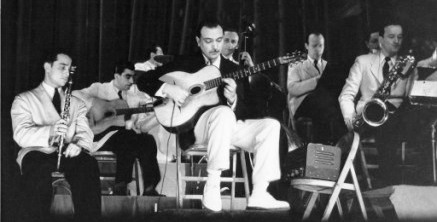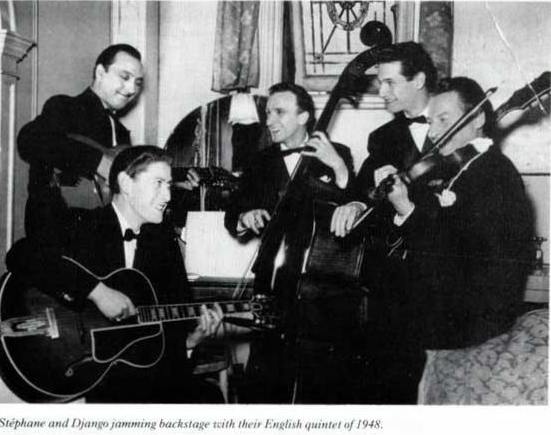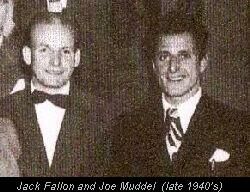Django’s Troublesome Bassists
Django was always concerned about the chord accompaniment. He just couldn’t understand that anybody could make mistakes. Especially annoying to him was a wrong note in the Bass Clef. To him, a wrong Bass note was an insult and he was often so rude to the Bass Player that they would leave, and so I was obliged many times to look for new Bass players. Once we got a new one who was a bit pretentious for our liking. Whenever Django asked if he knew such and such a tune, this Bass player always said, ‘Of course! What do you think, I’ve been playing for 20 years?’ One day Django got fed up with this sort of thing and suddenly asked, ‘Do you know Cherokee?’ ‘Of course!’ came the answer. ‘Well come on then’, and off Django went at a terrific speed and in B major! That was Django. But sometimes we had some poor Chap who was struggling to keep up, and Django would realise it and I would say, ‘He’s a bit nervous, don’t take any notice.’ That man could play any old kind of Bass and Django never said a word. You see, he was very temperamental, but inside he was a very kind man, and sometimes he didn’t realise that he was upsetting people. – Stephane
Stéphane tells us how he always had to go looking for new Bass players as Django kept giving them the Sack!
Louis Vola, Emmanuel Soudieux, Francis Luca, Len Harrison & Jean Storne which leaves from the people we know performed several times with Django around that period:-
Lucien Simoens
Tony Rovira
Wilson Myers
Eugene d’Hellemmes
Sigismond Beck
There are also some visiting Americans
Bass Players shuffled through the Quintette like cards dealt in a game of belote — Louis Vola, Sigismund Beck, Roger “Toto” Grasset, Eugene d’Hellemmes. The motley Parade of Bassists finally ended in 1938 when 19-year-old Emmanuel Soudieux tuned up his instrument for a Quintette Gig
LouisVola
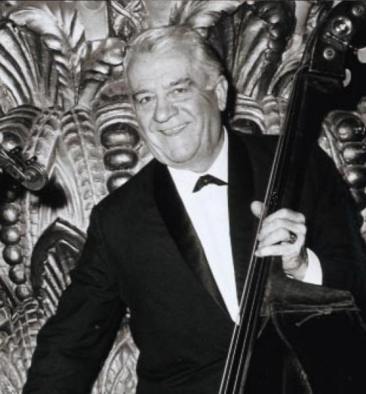 The 1st engagement Vola obtained for Django was with his band at the Palm Beach Casino in Cannes and Reinhardt started as he meant to carry on by often failing to turn up for the gig and flooding the area with the Caravans of his many “Cousins”. Despite this behaviour, Vola knew Django was something special and worth nurturing even with the inevitable aggravation and consternation that would be involved.
The 1st engagement Vola obtained for Django was with his band at the Palm Beach Casino in Cannes and Reinhardt started as he meant to carry on by often failing to turn up for the gig and flooding the area with the Caravans of his many “Cousins”. Despite this behaviour, Vola knew Django was something special and worth nurturing even with the inevitable aggravation and consternation that would be involved.
Louis Vola was born in the Riviera Town of La-Seyne-sur-Mer on 6th July, 1902 to an Italian shoemaker. He first started to play his father’s accordion and became passably competent on several instruments. His visits to the bal musettes fired his enthusiasm for music and after a brief spell as a baker, Vola learnt to play the double bass and became a full-time Musician. He often acted as the peacemaker between Django & Stephane but later expressed the view that their continual squabbling was very tiring. “I felt like leaving them to get on with it” he said.
By the outbreak of War, Vola was playing regularly with the Ray Ventura Orchestra and together with many of its members, he fled to South America where he remained for 8 years. Before doing so, he was featured in the 1939 Ventura film “Tourbillon de Paris” playing himself. When he returned to Paris, the music had moved on and left him somewhat marginalised. After a failed attempt to run a Restaurant in Nice, Louis Vola joined the Scheherazade, a fashionable Russian Restaurant, where he remained for 30 years. “My Double Bass plays by itself” he joked.
Probably Louis Vola‘s greatest contribution to Music was the discovery and early mentoring of Django Reinhardt and then acting as a catalyst between Reinhardt & Grappelli. However, he probably made the most of his rather limited musical ability and was, without doubt, a competent Session Musician working with many well-known Performers. Perhaps Vola’s attitude is best illustrated by the fact for his many years at the Scheherazade he was primarily the Bass Player but also doubled on piano & drums and was paid accordingly. In the late 50‘s he retired to Cachan and died there in August 1990.
QHCF
Louis Vola, the Bass player with the original Quintette Du Hot Club De France, an affable, Maurice Chevalier type of man, he talks glibly of his 15-year old granddaughter who plays the piano and can relate many tales about Django. He really knew Django the longest, starting at Toulon, where Vola had a Band.
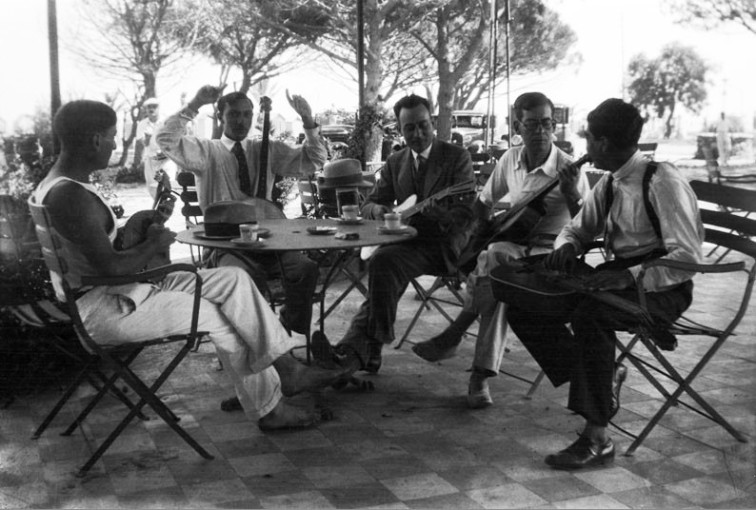
Django in the centre left with Emile Savitry (glasses) Joseph Reinhardt, Gusti Malha to the left and another unknown Banjoist in Toulon, 1930.
He heard the 2 Gypsy brothers, Django & Joseph playing on the beach one night and invited them to jam after hours with some of the members of his Band. One member of note was Stephane Grappelli. Vola subsequently moved to the Palm Beach Hotel at Cannes and hired Django alone, as an accompanist for his own accordion. Later, when Vola switched to bass, he hired Eugene ‘Nanine’ Vees, Joseph Reinhardt & Stephane Grappelli, in addition to Django – thus the Quintette Du Hot Club De France was born. Shortly after it was started on its recording career by Charles Delaunay & Pierre Nourry.
Roger ‘Toto’ Grasset – Bass
The Cabaret Bricktop’s welcomes in 1934 in the Company of Edmond Cohanier Alain Romans & Roger Grasset (bass)
Roger “Toto” Grasset on Bass – indeed Grasset was in the line up of the Quintet at that time, because he had to replace Vola for a while. Grasset joined the Tour to Great Britain then. Grasset had glasses, a moustache (to tell the truth he was a little bit stocky). Perhaps they changed the Bass player because Grasset didn´t look like a character out of “Scarface” like Joseph & Baro did.
Emmanuel Soudieux
Jazz Bassist Emmanuel Soudieux worked in Musette & Tango Orchestras. He was known for his Membership in the QHCF and since 1938 he played in the bands of Django Reinhardt and Stephane Grappelli. Soudieux then played intermittently until 1947, Reinhardt, as well as in the last Session for “Swing” with the Guitarist in November 1947, the title “Peche à la Mouche,” “Belleville” & “Manoir de mes Rêves “. About Soudieux Reinhardt once said, “he was incarnate music”. In the band of Jacques Diéval he entered the 1949 Festival International de Jazz in the Salle Pleyel, and in 1950 he played in a Trio with Doc Cheatham and Diéval and accompanied them with the singer Eartha Kitt . In the late 1950s he worked with Hubert Rostaing and Henri Crolla .
The writer Boris Vian Soudieux counted alongside Lucien Simo , who also worked with Django Reinhardt, one of the best Bass players in the immediate post-War France.
Any Images out there?
Alf ‘Totol’ Masselier
Although he studied classical music, he is considered a “jazz man”. He really lived the historic Saint Germain des Prés epoch: Boris Vian recruited him in 1948 at the Club Saint Germain and he performed there with great American Jazz Musicians such as Charlie Parker, Kenny Clark, Coleman Hawkins, Bing Crosby, Sammy Davis Jr, & Lester Young. He was, and is, in great demand, whether by Charles Trenet or Django Reinhardt with the Quintet of the Hot Club de France, or by Jacques Brel for “L’Homme de la Mancha”. He was the 1st bass player to accompany Sidney Bechet at his arrival in France. When “Totol” plays in an Orchestra, his efficiency & extraordinary sound prevail. To the delight of the Audience, he loves to sing & improvise at the same time on the double bass & bow. as did Slam Stewart.
Pierre Michelot
 Pierre Michelot was arguably the most talented Bass player to work regularly with Django. He played with him during the Club St Germain engagement in 1951 and was on the only formal Reinhardt Recording Session of 1952. He then appeared on Django’s last 2 Recordings in March & April of 1953.
Pierre Michelot was arguably the most talented Bass player to work regularly with Django. He played with him during the Club St Germain engagement in 1951 and was on the only formal Reinhardt Recording Session of 1952. He then appeared on Django’s last 2 Recordings in March & April of 1953.
Michelot was born in 1928 and learned to play the piano as a child before studying classical double Bass at 16. He was attracted to Jazz by Jimmy Blanton and Oscar Pettiford, both Pioneers of Modern Jazz Bass. During the late 40s, he became a well-known figure around the Parisien Club circuit playing with major Jazz Musicians like Rex Stewart, Coleman Hawkins, Zoot Sims, Lester Young, Dizzy Gillespie, Bud Powell & Dexter Gordon. He often claimed that during the final Recording Session with Django, he (Michelot) had a premonition of his imminent death precipitated by the melancholic aura created by his playing, particularly on “Nuages“. He said he felt an involuntary “shiver” everytime he subsequently heard the Record played.
Michelot (the Bassist on all of those last Recordings 1951 – 1953 is quoted in the notes to the Jazz in Paris – Nuages cd (which covers the March & April 1953 sessions)
“He liked this session. I think, but when it was released almost everyone was indifferent. Yet he was at a turning point in his musical expression , and open to everything new. Changing his famous sound, he was using an Electric Guitar which was nothing like the makeshift Instrument he had at the end of the 40s, and his mastery of it was perfect“.
In 1951, Django Reinhardt plays regularly with a band made up of the best Be-boppers French: Roger Guerin, Hubert & Raymond Fol, Pierre Michelot, Bernard Peiffer, Jean-Louis Viale. Always at the forefront of Jazz, Django recorded his last record April 8, 1953, with Martial Solal on piano, Pierre Michelot on Bass, Fats Sadi on Vibes and Pierre Lallement Lemarchand on Drums. He died 1 month later, 16th May 1953, of a cerebral haemorrhage.
Django, Pierre Michelot, Pierre Lemarchand at Club St Germain, 1951
Eugene D’Hellemmes
Bill Coleman and his Orchestra
Personnel (prob.): Bill Coleman tp, Eugène d’Hellemmes b, Edgar “Spider” Courance ts, Oscar Alemán g, William Diemer dm
Paris, c. 1936
Freddy Taylor & his Swing Men from Harlem
Personnel (from left to right): John (Jean) Ferrier p (bearing Taylor’s tp?), Charlie Johnson tp, Eugène d’Hellemmes bass, Arthur Chester Lanier cl as bs, Oscar Alemán g, Fletcher Allen cl ts,, Wiliam Diemer dm. Freddy Taylor is absent.
Paris, c. March 1935
Out of Nowhere
Alix Combelle (cl, ts) Andre Ekyan (as) Benny Carter (as, tp) Coleman Hawkins (ts) Stephane Grappelli (p) Django Reinhardt (g) Eugene D’Hellemmes (b) Tommy Benford (d)
Francis Luca
Jean Storne
Photos taken in late 1945 with Gerard Leveque – Clarinet, Joseph Reinhardt – Rhythm, Jean Storne-Bass, Andre Jourdan Drums – shows Django with early Amplification on his Selmer in a Big Band set. You can see the Electric Cord hanging from his Guitar (perhaps using some kind of contact ‘mic’ given to him by a US Serviceman) and the bulky amplifier on the chair in front of him. This appears to be mounted behind the bridge and could have been a DeArmond Contact Pickup fixed behind the Bridge or under the Strings – alas Django’s pick-hand obscures all and the Amp may have been custom made from the States
The British Bassists –
Len Harrison 1912-77
Len Harrison was a Base Clef man, performing with vigour on both Bass & Bass Saxophone and even picking up the odd credit, and it is an odd one at that, for playing contrabass trombone with Django Reinhardt. Not that it would be any harder to keep up with the Gypsy Guitarist on Contrabass Trombone than any other Instrument. Harrison was also utilised as both a Baritone & Tenor Saxophonist by Bandleaders such as Benny Carter, an adept arranger who made good use of multi-Instrumentalists.
Active on the British Jazz Scene from the mid-’30s, this Player was eventually catagorised simply as a Bassist. By this time the makings of a hefty discography already existed as the result of the aforementioned Reinhardt & Carter projects, the latter Artist having organised a special large ensemble for one of his earlier European tours. Harrison was often the choice for such international mixtures, including Fats Waller & His Continental Rhythm. Also featuring Guitarist Alan Ferguson, this Group recorded a series of Tracks in London in 1938.
Teddy Wadmore
– who played with the 1st international touring English Quartet
In 1948 Malcolm Mitchell Guitarist was called on to play with Stephane Grappelli & Django Reinhardt for an 8-week Tour of Sweden. All other references to this Tour indicate the group was Malcolm Mitchell, Alan Mindel (gtrs) & Teddy Wadmore (bass). In fact, Mitchell wrote an article confirming that particular combination for Scandinavia.
Teddy Wadmore went on the play Jazz & Blues with Alexis Korner’s Blues Incorporated on Electric Bass as was Jack Bruce
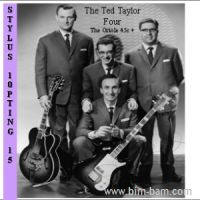 Ted Taylor Four 1958 –
Ted Taylor Four 1958 –
Ted Taylor on right, Bob Rogers on left & Teddy Wadmore, seated, with the very first Supersound Electric Bass (built in summer 1958) which he used on the Jack Jackson TV show in that year.
The Story of Supersound UK Amplifier
Coleridge George Emerson Goode
(born November 29, 1914)
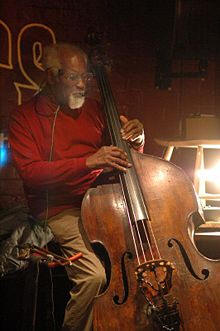 One of the finest jazz bassists who has worked in Europe, he is an important link to a proud heritage of Caribbean contributions to jazz music. His achievements through a long career have been an important inspiration for some leading contemporary black British jazz musicians. In 2002, his Autobiography co-authored with his friend, the academic and jazz writer Roger Cotterilll, not only told his own story but provided poignant and vivid memories of the brilliant and tragic Saxophonist Joe Harriott and of the birth of free form jazz in Britain.
One of the finest jazz bassists who has worked in Europe, he is an important link to a proud heritage of Caribbean contributions to jazz music. His achievements through a long career have been an important inspiration for some leading contemporary black British jazz musicians. In 2002, his Autobiography co-authored with his friend, the academic and jazz writer Roger Cotterilll, not only told his own story but provided poignant and vivid memories of the brilliant and tragic Saxophonist Joe Harriott and of the birth of free form jazz in Britain.
The Abbey Road Recorded English/Caribbean/French Quartet of Django, Allan Hodgkiss (Hodgkins) Archtop, West Indian Bassist Coleridge Goode, & Jack Llewellyn on Selmer Grande Bouche concealed by Stephane.
The personal highlight of his career was playing & recording with Django Reinhardt. When Django Reinhardt came to England after the 2nd WW to Record with Stephane Grappelli, the remaining members of his Quintet could not obtain authorisation to cross the channel (Passports). So he had no choice but to use the Guitarists & Bassist who usually accompanied Stephane Grappelli, who were Allan Hodgkiss, the Jamaican Bassist Coleridge Goode & Jack Llewellyn. On 31st January 1946 they recorded four songs at Abbey Road studios,
31st January 1946 Swing, London
Django Reinhardt & the Quintet of the Hot Club of ‘France’ with Stéphane Grappelli
Stéphane Grappelli (v); Django Reinhardt (g solo); Jack Llewellyn, Allan Hodgkiss (g); Coleridge Goode (b)
Coquette, Django’s Tiger, Embraceable You, Echoes Of France,
‘The Marseilles‘ version was banned in France as disrespectful to the national anthem and hence renamed ‘Echoes of France‘
“I was born in 1914, in Kingston Jamaica,” he recalls with some pride. “My father was a choirmaster and organist who promoted classical choral music in Jamaica and my mother sang in the choir.” I mention that Coleridge is an interesting Christian name and Goode is only too keen to fill me in. My name comes from my father putting on a performance of Samuel Coleridge Taylor’s ‘Hiawatha’s Wedding Feast’ as a tribute to him,” starts Goode. “I was born a year after – so that’s how I got my name.” So when and with what, did Goode start his musical journey? “It all started from a concert of my father’s that I went to,” he says in measured tones. “The cellist was playing a beautiful solo and it impressed me enough to go home and put some orange boxes and wood together and try and make an instrument. My father saw me doing this and bought me a violin for my imminent 11th birthday.”
Jack Fallon
Patrick Fallon (Jack Fallon), bassist, violinist & agent: born London, Ontario 13 October 1915; died London, 22 May 2006.
A British jazz bass player before 1946 didn’t have a chance. By definition he swung like a pendulum. Jack Fallon came to England with the Canadian Air Force Band in that year and settled there when his Service was done. He transformed Bass playing in Britain for ever. His playing swung and lifted and he had a big, fat tone that inspired everyone with whom he played. It was some years before his fellow Bassists began to fulfil their aspirations. Fallon had a remarkable career during which he played with every imaginable kind of Artist from Spike Milligan & Django Reinhardt to the Beatles & Duke Ellington. A quiet and modest man, he reflected on his career when it was all over and said, “I just banged it out as best I could. I had a lot of luck.”
“I was born in a log cabin on a 100-acre farm in Ontario,” wrote Fallon. His sister Irene Fallon, who entered a convent as Sister Rosary, had another view. “A log cabin called St Joseph’s Hospital,” she said. After playing violin in a family Band Fallon took up the Bass in 1935. He played the Trumpet in the Air Force’s Band as well as Bass in its Dance Band the RCAF Streamliners. He sent his Bass back to Canada when his Duties were over but then decided against joining it. “Somebody offered me money,” he explained.
He joined the Ted Heath Band in April 1946 and stayed until September. He played in Night-clubs and at the haunts of the early British Bebop players like the Feldman Club in 100 Oxford Street where the music was difficult for both Musicians & Audiences alike. “If I was having trouble I could always have a coughing spell,” Fallon said modestly.
